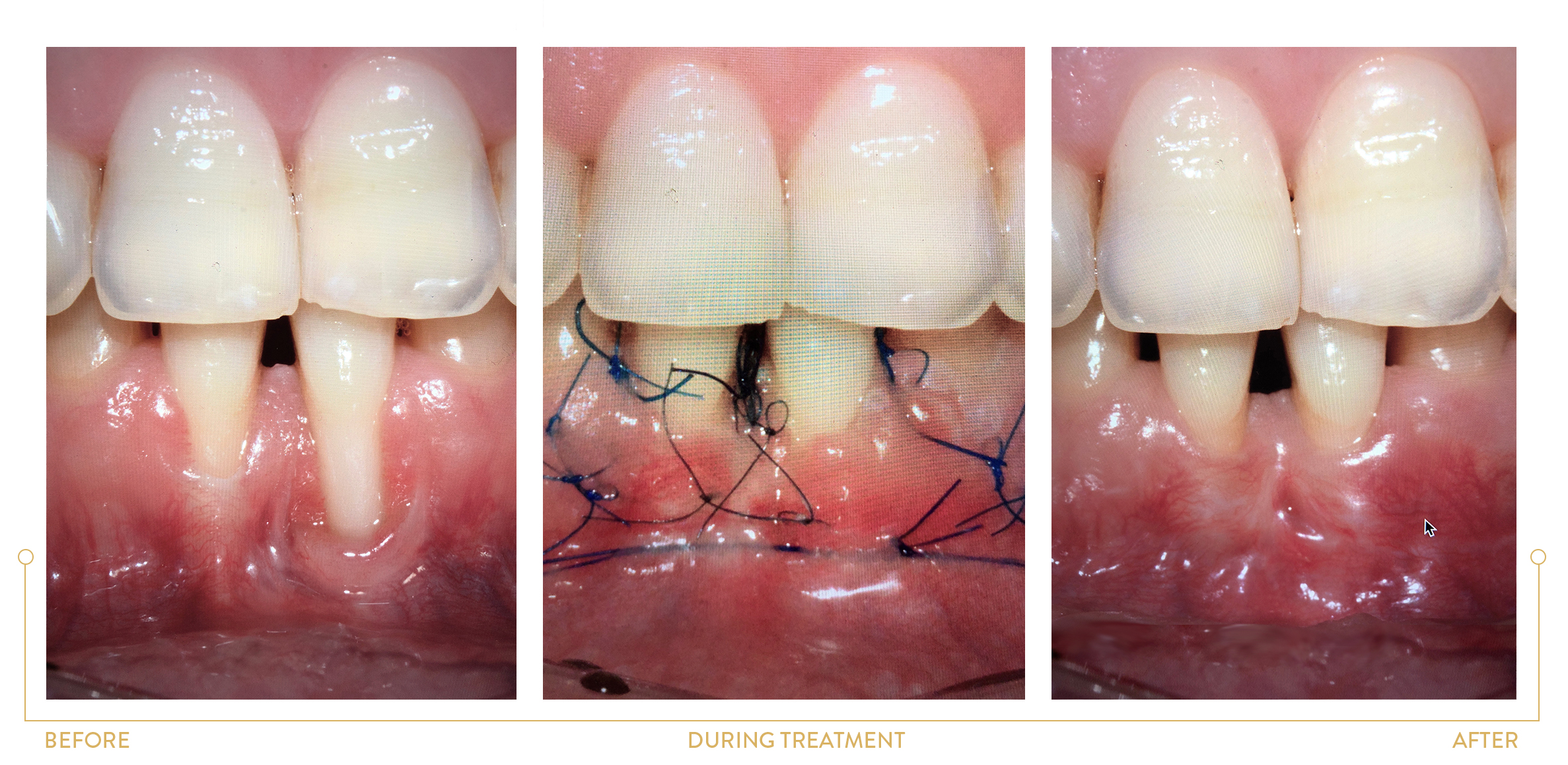What does periodontics do?
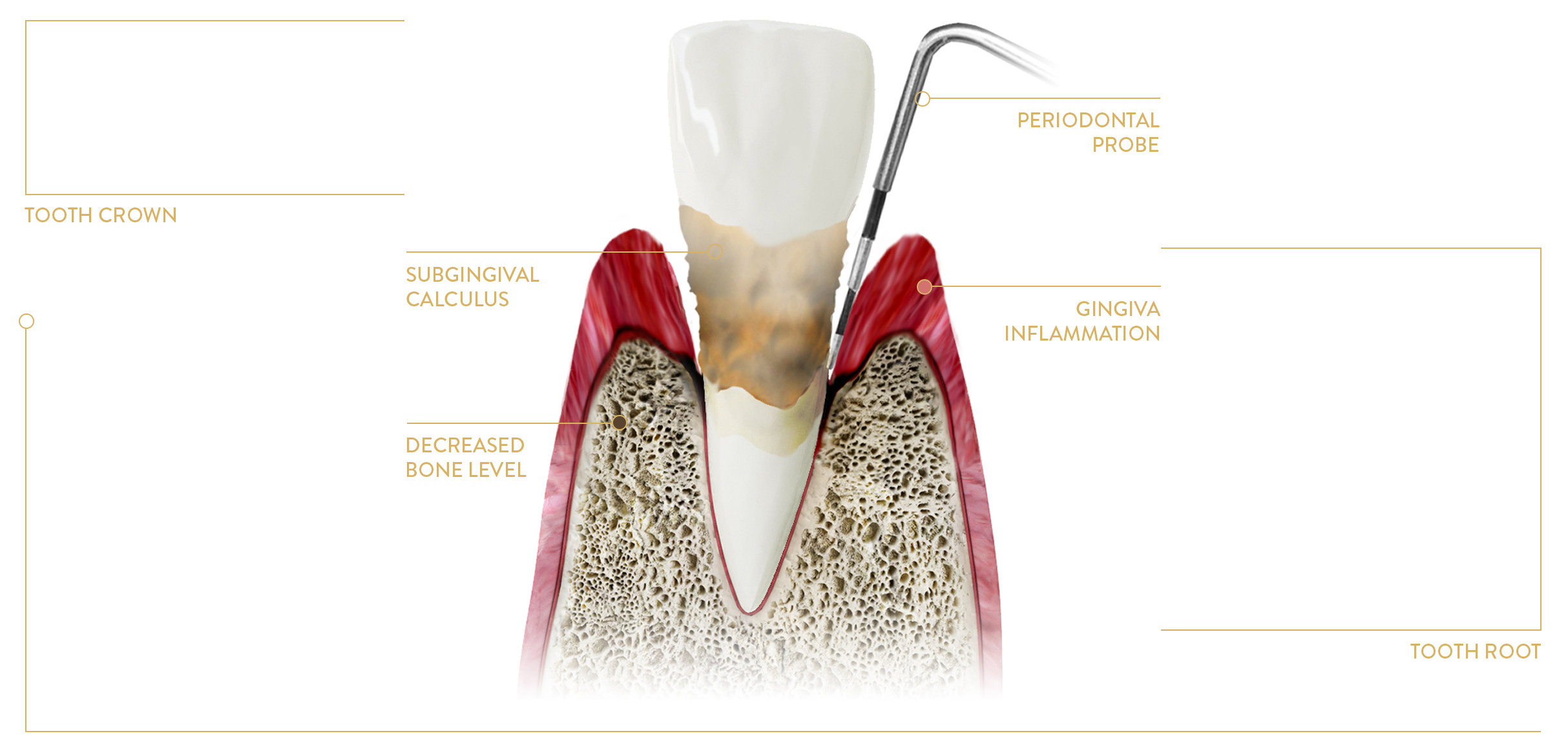
ADVANCED INFLAMMATION OF the PARODONTIUM (FORmerly known as “PERIODONTOSIS”)
Periodontology or periodontics is a branch of dentistry that deals with the treatment of periodontal and oral mucosa diseases. Problems with the tissues surrounding the teeth are very common. The most common condition is periodontal disease, also known as “periodontosis”.
It is important to report to a dentist at the first sign of disturbing symptoms, so that treatment can be administered as soon as possible. These include:
- redness or bleeding of the gums
- receding gums revealing the necks of the teeth
- hypersensitivity
- feeling of loose teeth
- bad breath
Such symptoms should not be ignored or underestimated, as untreated periodontal disease can lead to complete loss of teeth.
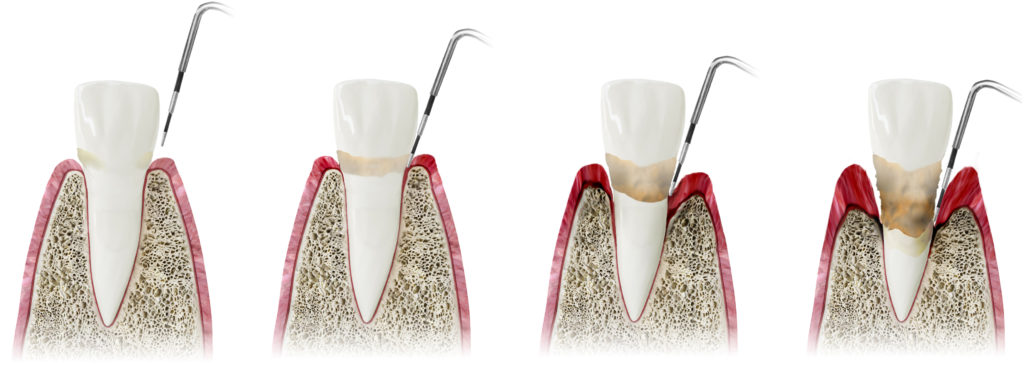
PROCEEDING INFLAMMATION OF PARODONTIUM
Treatment methods
Surgical – regenerative periodontal treatment

Receding gum treatment
Receding gum treatment involves covering the exposed tooth root surface and restoring and thickening the gingival line. The treatment is very precise and is performed under local anaesthesia. It is not always enough to simply reposition the gum, so additional fragments of tissue are often taken from elsewhere, for example from the palate.
The treatment has the additional benefit of enhancing the appearance of the patient’s smile, which can be disturbed by gingival recession.
Surgical – resective periodontal treatment
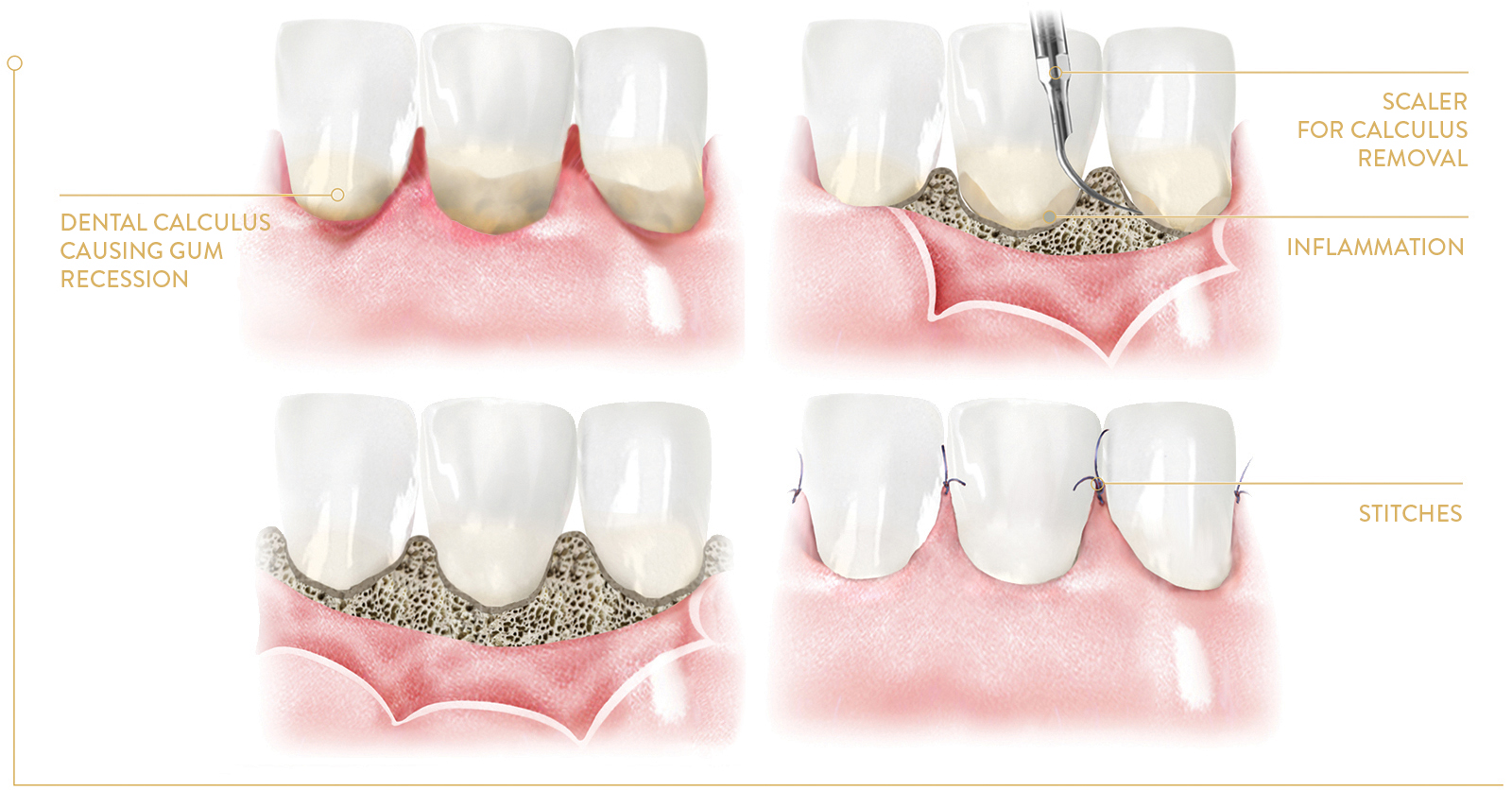
Gingival flap surgery
Surgical procedures make it possible to eliminate inflammation that cannot be removed by dental hygiene treatment.
Gingival flap surgery is the removal of inflamed lesions of periodontal tissues and reconstruction of periodontium, bones and gingiva lost as a result of periodontal disease. The procedure usually involves surgical debridement of the bones and removal of inflammatory foci from the periodontium to enable bone regeneration. Flap surgeries are performed under local anaesthesia. The periodontist cuts the gingiva and mucous membrane around the inflamed bone. This reveals the root of the tooth and the alveolar bone in order for the dentist to have free access to the inflammatory focal point and can see it clearly. Using the appropriate micro-tools, the doctor removes infected tissue and all inflammatory focal points, and rinses the surgical site with saline or antibiotic solution. After this treatment, stitches are applied to the wound, which are removed after about a week.
flap surgery
Other periodontal treatments
Correction of “gummy smiles”
Gummy smile describes a disproportion between the so-called white zone (the patient’s teeth) and the red zone (gums). This disproportion is the result of an incorrect relationship between the position of the jaw, the position of the teeth, the position of the lower border of the upper lip and the position of the gums in relation to the crowns of the teeth. The lack of balance between these elements creates the impression of short teeth in relation to the gums, thus disturbing the aesthetics of the smile.
Causes of the disease:
- genetic defect associated with excessive jaw bone growth
- orthodontic defects
- bruxism
- short upper lip
- delayed teeth eruption
GUMMY SMILE BEFORE AND AFTER TREATMENT
There are several techniques in the field of dentistry and aesthetic medicine available to deal with the problem of a gummy smile. One of them is the surgical elongation of clinical crowns and removal of excess gums. The procedure is carried out by a periodontist and performed under local anaesthesia, which guarantees painless treatment.
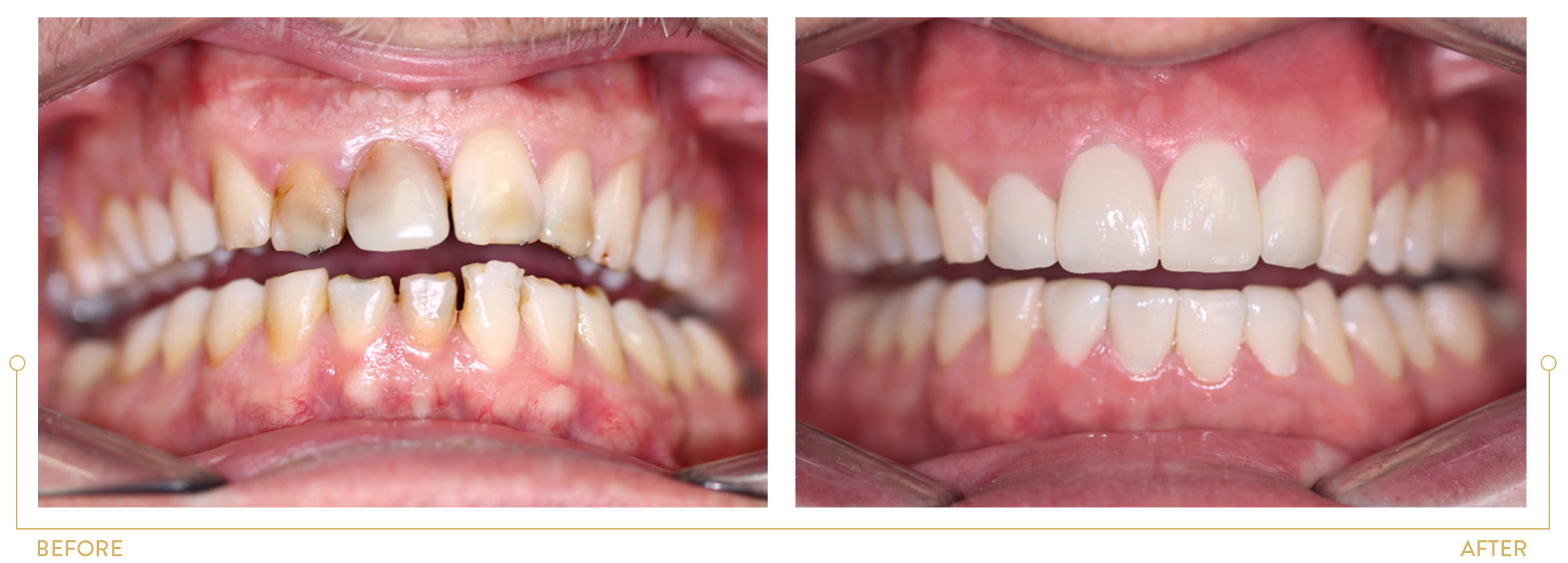
extension of teeth crowns
After the surgery, it may be necessary to produce dental veneers or all-ceramic crowns in order to restore the correct proportions and shape of the teeth.
In extreme cases, it is also necessary to change the shape of the jaw bone itself or perform other periodontal or orthodontic procedures, or even maxillofacial surgery.
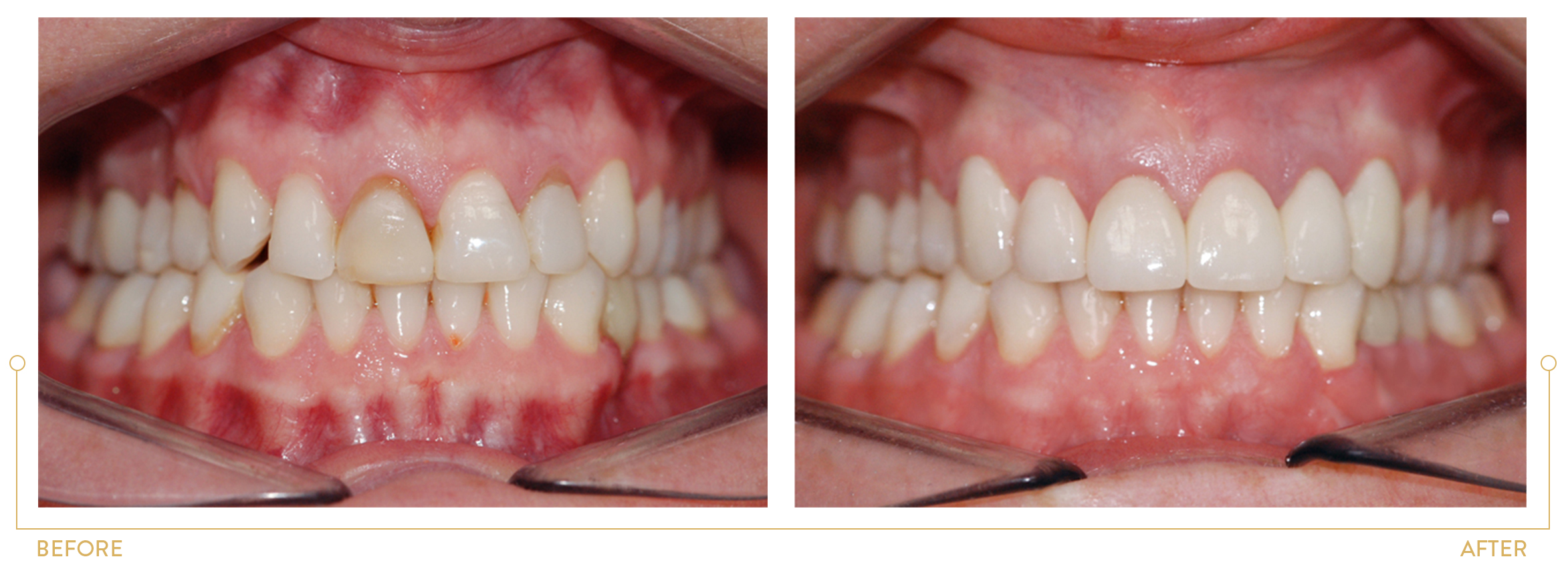
LEVELLING OF GINGIVAL LINE
Non-surgical periodontal treatment
Deep/subgingival scaling is a method of removing subgingival calculus, which involves using specialised tools (cortices) to manually remove subcutaneous calculus build-up from the root surface, combined with teeth polishing (smoothing). Subgingival calculus is located below the gingival line, on the root of the tooth, which destroys the structure that holds the tooth in the alveolus, resulting in increased mobility, bone atrophy, and eventually loosening and loss of teeth. Since it adheres more closely to the tooth root surface, it is more difficult to remove.
Prevention
Periodontal disease is associated with the accumulation of bacteria on the teeth, gums or prosthetic restorations. Therefore, appropriate prevention plays a key role in maintaining adequate health. Daily dental care is of particular importance: how we brush our teeth and what we use for it, as well as how often we change our brushes for new ones. Even the type of toothpaste and mouthwash can be important. To minimise the risk of periodontal problems, it is recommended to undergo a professional tooth cleaning procedure at least once a year. At Cichoń Dental Centre we offer dental hygienic treatments: scaling and sandblasting, and treatment of periodontal diseases using open or closed curettage, as well as teeth splinting.
Frequently asked questions
Can periodontal disease be treated? How can it be prevented?
Modern dentistry offers a wide range of periodontal treatment methods. It is worth noting that the early stages of the disease can be alleviated and treated with painless and simple procedures in the dental practice. First, dental hygiene treatment is recommended, during which the dental hygienist thoroughly removes deposits of calculus and plaque, thus protecting the teeth against hypersensitivity and the rapid appearance of sediment. In cases of advanced periodontitis, surgical intervention is necessary. These cases require procedures such as curettage, gingivoplasty and controlled regeneration of the lost bone and periodontal tissues.
How should one brush their teeth?
Teeth should be brushed for at least 3 minutes. If possible, brushing after each meal and after consumption of sweetened beverages is recommended. It is worth remembering that interdental spaces should also be cleaned using dental floss, toothpicks and irrigators. It is worth consulting a doctor or hygienist about brushing techniques during an appointment.
What affects the development of periodontal disease?
The main cause of periodontal disease is inadequate and incorrect oral hygiene.
There are also circumstances conducive to the occurrence of periodontal disease. These include:
– rheumatoid diseases
– diabetes
– vitamin deficiencies
– genetic factors
– crowded teeth
Smokers, people who consume large amounts of alcohol and older people are at increased risk of periodontal disease.
Are there any contraindications to sandblasting teeth?
Almost everyone can undergo this procedure without fear.
The exceptions are those:
– with soda allergy or allergies to other ingredients involved
– with wounds in the mouth
– with gum and mouth inflammation
– suffering from asthma or pneumoconiosis
After conducting a medical interview, the dentist assesses whether sandblasting is recommended for a given patient.
What colour are healthy gums?
Healthy gums should have a bright pink colour. Gums that are too pale may indicate anaemia or another systemic disease. Similarly, redness of the gums, especially connected with bleeding or itching, may be a symptom of inflammation.
Is it true that it is not possible to perform dental hygiene treatment when wearing an appliance?
Absolutely not! In the case of wearing the appliance, dental hygiene treatment is recommended as often as every 3 months. Patients who opt for orthodontic treatment should remember that when using an orthodontic appliance proper oral hygiene is of great importance and can contribute to the success of the treatment.
What does a full oral cavity hygiene treatment involve?
The first stage of the procedure is scaling or calculus/tartar removal using ultrasound. The next stage is sandblasting to remove sediment and discolouration from the facial, occlusal surfaces and interdental spaces. The final, indispensable, stage is polishing with special polishing pastes. Effective polishing reduces the size of plaque deposits and makes them less likely to remain on teeth.
Is dental hygiene treatment painful?
No. The treatment should not cause pain, although it depends on the individual sensitivity of the patient. In cases of hypersensitivity, it is possible to ask for the procedure under anaesthesia.
How often should dental hygiene treatment be performed?
Oral cavity hygiene treatment should be performed at least every 6 months, and for orthodontic patients once every 3 months. The frequency of dental hygiene treatment is an individual matter. The hygienist will always inform you how often it should take place, in order to avoid gum recession or other diseases related to the periodontium.
How do I check if I clean my teeth thoroughly?
One method is using a fuchsin tablet.
After completing dental hygiene treatment at the Cichoń Dental Centre, the patient receives a tablet to check the correctness of brushing and flossing. After thoroughly chewing and spreading the tablet on the tongue, the old dental plaque will be stained an appropriate colour, informing you of any insufficient tooth brushing.
How does one take care for the hygiene of prosthetic restorations – crowns, bridges and works on implants?
It is recommended to perform oral cavity hygiene at least once every six months. Professional oral hygiene is performed with the help of special tips that allow you to safely and thoroughly clean the area of prosthetic elements. In addition, low granularity and mildly abrasive sand is used, which protects the crowns from damage.











